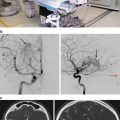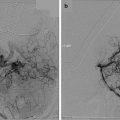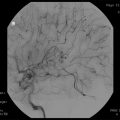First author
Patients
FU length
Lesion location
Clinical presentation
Annual bleeding risk
Comment
Robinson [7] (1991)
66 patients
26 months
Supratentorial: 55 patients
Seizures: 34 patients
0.7 % per lesion
– HRG common in female and in infratentorial lesions
Deep: 4 patients
Focal deficit: 30 patients
Cerebellar: 9 patients
HRG: 6 patients
Brainstem: 8 patients
Incidental: 9 patients
Zabramski [4] (1994)
31 patients
2.2 years
Supratentorial: 92 %
Symptomatic: 61 %
HRG + symptom: 6 %
– Developed new cavernoma: 29 %
Multi: 84 %
Infratentorial: 8 %
Incidental: 39 %
HRG overall: 13 %
Aiba [22] (1995)
110 patients
4.71 years
Supratentorial: 65 %
HRG: 62 patients
Re-HRG: 22.9 % per lesion
– Younger and female patients had higher HRG risk
Deep: 11 %
Seizures: 25 patients
Brainstem: 18 %
Incidental: 23 patients
Kondziolka [23] (1995)
122 patients
34 months
BG/thalamus: 17 %
HRG = 1: 41 %
Total: 2.6 %
– No influence on location, sex, and number on HRG risk
Multi: 20 %
Brainstem: 35 %
HRG > 1: 9 %
No HRG: 0.6 %
Seizures: 23 %
Previous HRG: 4.5 %
Porter [2] (1997)
173 patients
46 months
Superficial: 109 patients
HRG: 25.4 %
4.2 % annual rate
– Significantly greater
Multi: 17.9 %
Deep: 64 patients
Seizure: 35.8 %
10.6 % deep location
Bleed rate for deep
Neurological deficit: 20.2 %
~37 % recovered from
Incidental: 12.1 %
new deficits
Labauge [11] (2000)
40 patients
3.2 years
Supratentorial: 176
HRG: 19 patients
11 % per patient
– 1/3 bleeds, symptomatic
Multi: 93 %
Cerebellar: 30
Seizures: 12 patients
2.5 % per lesion
– 27.5 % of patients develop new lesions
Brainstem: 26
Focal signs: 4 patients
Kupersmith [24] (2011)
37 patients
4.9 years
– 12 midbrain
HRG: 73 %
2.5 % per patient
– Young patient with lesion of >10 mm had higher risk of HRG
– 18 pons
Mass effect only: 22 %
5.1 % rebleeding risk
– 7 medulla
Asymptomatic: 5 %
Al-Holou [10] (2012)
92 patients
3.5 years
Supratentorial: 75 patients
Acute symptoms: 17 patients
HRG: 1.6 %/year
– Brainstem location
Multi: 30 %
Infratentorial: 1 patient
Chronic symptoms: 5 patients
Re-HRG: 8 %/year
and age increased
Incidental: 34
0.2 % if incidental
bleed rate
Salmon [25] (2012)
139 patients
5 years
Lobar: 67 %
Incidental: 47 %
HRG: 2.4 %/year
– Risk declines over
Multi: 17 %
Brainstem: 14 %
Seizure: 25 %
Re-HRG: 29.5 %/year
5 years and is higher
Cerebellum: 13 %
HRG: 12 %
HRG year 1: 19.8 %
for women
Deep structures: 6 %
Neurological deficit: 15 %
HRG year 5: 5 %
In older patients or patients with low-risk lesions which are difficult to reach surgically, observation with periodic imaging may be appropriate. When patients present with recurrent hemorrhage, progressive neurological deterioration, or intractable epilepsy, then treatment in the form of surgery or radiosurgery should be considered. The management options for a patient with a cavernous malformation must be based on age, symptoms, hemorrhage risk, and location, especially as it relates to surgical accessibility. Resection clearly provides immediate advantages for accessible lesions and complete resection is achieved in 91 % (62 % bleed rate in partially resected lesions) [26]. However, surgery on average has a 45 % postoperative and 15 % long-term morbidity [26]. These results can be much higher when resection of deep-seated lesions is conducted (Table 50.2) [27–33]. For younger patients with more accessible lesions, the removal of lesions may help control epilepsy, improve neurological deficits, and prevent any subsequent hemorrhage. Radiosurgery is a minimally invasive option for patients presenting with recurrent hemorrhages from deep-seated cavernous malformations.
Table 50.2
Summary of reports on resection of deep-seated cavernous malformations
First author | Patients | Location | Presentation | Immediate postoperative outcome | Long-term outcome |
|---|---|---|---|---|---|
Steinberg [27] (2000) | 56 patients | Brainstem: 42 | HRG: Average of 2.1 | 16 % improved | 43 % improved |
Thalamus: 5 | 55 % stable | 52 % stable | |||
Basal ganglia: 10 | 29 % worse | 5 % worse | |||
No death | 4 patients had re-HRG | ||||
Mathiesen [28] (2003) | 68 patients | Basal ganglia: 11 | Varied with location | 25/29 complete resection | Re-HRG: 4 partial resections |
Thalamus: 12 | HRG 1 or 2: 68 patients | 69 % neuro-decline | 20 patients improved | ||
Mesencephalon: 5 | Only 2 (5 %) permanent | (10 patients intact) | |||
Pons: 31 | 4 stable, 5 worse | ||||
Medulla: 5 | 1 died of rebleed | ||||
Wang [29] (2003) | 137 patients | Midbrain: 29 | HRG = 1: 45 patients | 131/137 total resection | Re-HRG: 3 partial resections |
Pons: 85 | HRG > 1: 58 patients | 72.3 % stable or improved | Death: 1 | ||
Medulla: 19 | HRG 3 or more: 34 patients | 27.7 % new deficits | 7.8 % living dependently | ||
Cerebellar peduncle: 8 | 60 % annual rebleeding | ||||
Ferroli [30] (2005) | 52 patients | Medulla: 7 | HRG = 1: 32 patients | 4 repeat surgeries | 19 % permanent deficits |
Pontomedullary: 3 | HRG > 1: 18 patients | 29 patients stable | |||
Pons: 31 | No HRG: 2 patients | 23 patients worse | |||
Pontomesencephalic: 3 | HRG: 3.8 % annual risk | 1 death | |||
Midbrain: 6 | Re-HRG: 34.7 % annual | ||||
Hauck [31] (2009) | 44 patients | Pons: 25 | HRG = 1: 20 patients | Improved: 30 % | Residual: 1 |
Midbrain: 11 | HRG > 1: 23 patients | Stable: 59 % | Re-HRG: 2 patients | ||
Medulla: 8 | Worse: 11 % | Revisions: 8 patients | |||
Abla [32] (2011) | 260 patients | Pons: 112 | HRG: 252 patients | New deficits: 53 % | Death: 3 |
Medulla: 29 | New deficits: 7 patients | Residual lesion: 29 | New deficit: 36 % | ||
Midbrain: 49 | Re-HRG: 7.7 | Improved: 45 % | |||
Pontomedullary: 40 | Died: 2 | Re-HRG: 2.0 % | |||
Pontomesencephalic: 31 | |||||
Pandley [33] (2012) | 176 patients | Pons: 94 | HRG = 1: 70 patients | Second operation: 17 patients | Death: 3 |
20 pediatric | Midbrain: 28 | HRG > 1: 102 patients | New deficit: 31.3 % | Improved: 61.8 % | |
Medulla: 14 | Seizure: 4 patients | Improved: 19.9 | Stable: 25.9 % | ||
BG/thalamus: 43 | Re-HRG: 5 patients |
The Role of Radiosurgery
The successful management of cerebral AVMs with stereotactic radiosurgery prompted the exploration of its role in the management of cavernous malformations. The benefits of radiosurgery for cavernous malformations are difficult to assess because of its unclear natural history and the lack of an imaging technique that can document a “cure.” The role of radiosurgery in this disease is still considered controversial by many physicians. However, the lack of options for surgically inaccessible cavernous malformations has made radiosurgery a possible alternative to conservative management for lesions with a high risk of symptomatic bleeding (Table 50.3) [17, 34–40].
Table 50.3
Summary of some recent Gamma Knife radiosurgical series of cavernous malformations
First author | Patients/FU | Location | Presentation | Dose/volume | Outcome | Morbidity |
|---|---|---|---|---|---|---|
Karlsson [34] (1998) | 22 patients | Cortical: 8 | HRG: 16 patients | Margin: 18 Gy (9–35) | Post-GK HRG rate: 8 %/year | ARE: 6 patients |
Deep cerebral: 7 | Epilepsy: 6 patients | – Years 1–2: 10 % | – 5 symptoms | |||
GK | 6.9 years | Brainstem: 6 | Prior resection: 1 patient | – Years 3–4: 12 % | Onset 16 months | |
Cerebellum: 1 | – Years 5–6: 5 % | |||||
– Years 7–8: 7 % | ||||||
Hasegawa [17] (2002) | 82 patients | Supratentorial: 16 | HRG: 82 patients (1–7 bleeds) | Margin: 16.2 Gy (12–20) | HRG: 12.3 % first 2 years | ARE: 11 patients |
Deep: 13 | HRG rate: 33.9 %/year | HRG: 0.76 % years 2–12 | None after 1992 | |||
GK | 4.89 years | Brainstem: 52 | Prior surgery: 20 patients | Vol.: 1.85 cm3 (0.12–6.98) | ||
Liu [35] (2005) | 125 patients | Brainstem: 49 | HRG: 112 patients | Margin: 12.1 Gy (9–20) | HRG rate: 6.5 %/year | ARE: 13.1 % |
BG/thalamus: 14 | HRG >1: 45 patients | HRG: 10.3 % first 2 years | Symptoms: 2.5 % | |||
GK | 5.4 years | Cortical: 39 | HRG rate: 29.2 %/year | Vol.: 3.12 cm3 (.032–25.9) | HRG: 3.3 % after year 2 | |
Cerebellum: 10 | Seizures: 28 patients | |||||
Kim [36] (2005) | 42 patients | Cortical: 21 | HRG: 26.6 % | Margin: 14.55 Gy (10–25) | Seizure cessation: 75 % | Edema: 5 patients |
Brainstem: 6 | Seizures: 28.6 % | – Mean of 31.3 months | – Symptoms: 5 patients | |||
GK | 29.6 months | Basal ganglia: 5 | Neurological deficit: 45.2 % | HRG: 1 | – Recovered: 5 patients | |
Liscak [37] (2005) | 112 patients | Brainstem: 33 | HRG in 59 patients | Margin: 16 Gy (9–36) | HRG rate: 1.6 %/year | Edema: 30 patients |
Cortical: 54 | Seizures in 40 patients | Vol.: 0.9 cm3 (0.06–12.5) | – 2 deaths from HRG | – Symptoms: 17 patients | ||
GK | 48 months | BG/thalamus: 17 | Neurological deficit: 51 patients | Neurological deficits: 33 % improved | – Recovered: 16 patients | |
Cerebellum: 8 | 7 patients prior partial resection | |||||
Nagy [38] (2010) | 113 patients | Brainstem: 79 | HRG high risk >1: 41 patients | Margin: 12–15 Gy (10–20) | High risk <2 years: 15 %/year | ARE: 6 symptoms |
BG/thalamus: 39 | HRG low risk <1: 54 patients | Vol.: 0.33–0.83 cm3 | High risk >2 years: 2.4 %/year | |||
GK | 48 months | Neurological deficit high risk: 72 % | Low risk <2 years: 5.1 %/year | |||
Neurological deficit low risk: 43 % | Low risk >2 years: 1.3 %/year | |||||
HRG pre GK: 30.5 %/year | ||||||
Lunsford [39] (2010) | 103 patients | Brainstem: 66 | HRG >1: 103 patients | Margin: 16 Gy (12–20) | HRG <2 years: 10.8 %/year | ARE: 19 patients |
BG/thalamus: 27 | HRG pre GK: 32.5 %/year | Vol.: 1.31 cm3 | HRG > 2 years: 1 %/year | Symptoms: 12 patients | ||
GK | 67.8 months | Deep lobar: 10 | Seizures: 8 patients | 75 % seizure cessation | ||
Lee [40] (2012) | 49 patients | Pons: 34 | HRG >1: 49 patients
Stay updated, free articles. Join our Telegram channel
Full access? Get Clinical Tree
 Get Clinical Tree app for offline access
Get Clinical Tree app for offline access

|





